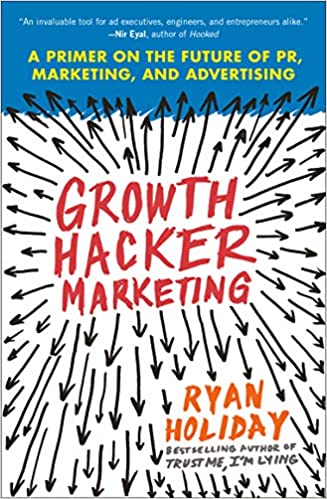From the title of the book “Growth Hacker Marketing: A Primer on the Future of PR, Marketing, and Advertising” by Ryan Holiday, it already becomes clear that it is dedicated to such a phenomenon as Growth Hacker Marketing. Growth hacker marketing is a way to promote a product without advertising. The main idea is that the product should sell itself, it should attract the attention of customers with its qualities and characteristics, while there is constant work to improve the product, the product adapts to the customer.

Growth hacking involves constant business growth without high marketing costs. Growth hackers have helped companies like Dropbox, Mailbox, Twitter, Facebook, Evernote, Instagram, Mint, AppSumo and StumbleUpon achieve and continue to achieve a lot with a minimum of investment.
Although growth hacking originated in the IT industry, these principles work for any business and any product.
The following principles of growth hacker marketing can be distinguished
- Create a product that is ideally suited to the market
- Use low-budget, but effective marketing
- Create virality
- Retention of users
- Constant experiments and analysis of results
Traditional marketing involves the release of the final version of the product to the market. The marketer’s work begins immediately before this release. He can only figure out how to better advertise what has already been created, even if it is obvious that this product will be unsuccessful.
Growth hackers believe that releasing the final version of the product without a preliminary test version is too expensive and inefficient. To minimize the risk that the product will be unsuitable, you need to get feedback from potential users as early as possible, before the final product is released.
So first you create test version, a simplified model of the final product. It is released to a small market for a limited number of users. Then feedback from the first users is actively collected, and changes are made to the product based on this. This cycle can be repeated several times, each time an improved prototype is released and feedback is collected again.
Product-market fit
Until finally the product meets the needs of the market. This match is called product-market fit (PFM). The product can only be released after the PFM has been reached.
Achievement PFM is the result of consistent work, consisting of continuous testing, collecting feedback, and improving the product (and repeating this cycle many times). At the same time, this work does not stop even after entering the market. Growth hackers see the product as an agile model that can and should be changed.

Traditional marketing forces sellers and marketers to prove the value of the promoted product, even if it has almost no value. Growth hackers set themselves the task of creating products with real value that can be noticed and evaluated even without advertising. They want to achieve a wow effect, so that consumers are not just satisfied, but delighted with the product.
Achievement PFM is the most important thing for growth hackers. Further steps do not make sense without it. Therefore, if the startup’s budget is limited, it is better to spend most of the money on testing and improving the product, rather than on advertising it.
Growth hackers believe that it is not necessary to try to inform a large audience about the product’s release at the very beginning of promotion. Therefore, instead of immediately increasing brand and product awareness among a large number of people, growth hackers start with targeting. They single out and try to attract the target, most interested audience.
Who your customer is and where to find them is also a key question for traditional marketing. But growth hackers respond more accurately by actively using targeting and analytics tools. As a result, they only use channels with a high concentration of the target audience for promotion.
Ryan Holiday lists the ways growth hackers find their first users
- Report the release of the finished product to people who tested the prototype
- On special events, in the highly specialized media and social networking groups
- Collaborate with opinion leaders (bloggers, famous people) who belong to the target audience or have influence on it
- Using crowdfunding. Crowdfunding is one of the ways to get financial support for starting a business. Crowdfunding is a collaboration method in which people collect money and other resources to support a project. This helps you solve two tasks at once: attract users and organize pre-sales
- Create high-quality thematic content that is interesting to the target audience
Ryan Holiday advises that if the budget is limited, the bulk of it should be spent on improving the product, not on advertising. But you still need to promote the product, only you should use low-budget, guerrilla, and word-of-mouth marketing techniques instead of expensive methods.
Ryan Holiday describes the main differences in user engagement methods between growth hacking and traditional marketing:
- Low-Budget marketing instead of expensive advertising
- Testing methods of promotion
- Free test versions or trial period of using the product
Growth hackers pay great attention to connecting with users and solving their problems.
This approach solves two problems at once
- Receiving feedback and maintaining product compliance with market needs (product-market fit)
- The reputation of the brand, the neutralization of the negativity
Ryan Holiday advises using viral marketing in growth hacking. He believes that there are three viral trends:
- Product
- Content
- Special offers
Information about a viral product, content, or special offers continues to spread, even if paid advertising is completely disabled.
You can also achieve virality by using
- Wow effect – the product or content exceeds expectations. If something is admired, the probability that a person will recommend it to others increases greatly
- Tools that facilitate the dissemination of information (referral links, discount coupons for a friend)
- User benefits (bonuses for users)

According to the author, user retention is just as important as attracting users. Since it is usually more difficult and expensive to sell to a new customer than to someone who has already been interested in the product and even more so bought it before. To keep users, growth hackers analyze their behavior and build sales funnels based on this data.
Ryan Holiday lists the following tools for building a sales funnel:
- interactive and interesting instructions for using the product
- reminders (by email, by phone, with the help of context advertising)
- bonuses that encourage you to return to using the product or buy another product from this seller (for example, coupons with a discount on the next purchase)
Growth hackers pay a lot of attention to specific numbers, metrics, and ways to track them. Therefore, they test everything: products, promotion methods, ways of retention users and increase conversion. Growth hackers always strive to improve metrics and look for opportunities for growth at every stage of the company’s existence.
Ryan Holiday believes that any technique that helps a business grow quickly can be considered growth hacking.
Ryan Holiday’s book can help you re-analyze your marketing working, look at your product from a new perspective, and think about whether you need a new approach to promote your product. And this approach can be Growth Hacker Marketing.
Find more marketing and sales Book Reviews in the special section of the website.




